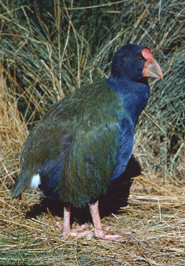| |
 |
Assumed to be extinct for half a century .....
Takahe were once abundant throughout New Zealand. The first recorded specimen was
caught alive on Resolution Island in 1849 by a seal hunter's dog. Another three takahe
were found the same way, but this was all that was known about the bird in 1900 so it was
assumed to be extinct.
Dr Geoffrey Orbell undertook an intensive two-year search in a wet, remote region of the Murchison Mountains in Fiordland, where 250 inches of rain fall in a year. In 1948 he rediscovered two takahe near the shores of Lake Orbell, causing a sensation amongst ornithologists throughout the world.
Then 400 more birds were found in the alpine tussock grassland of the Murchison Mountains and two adjoining ranges.
Photo above: Crown Copyright © Department of Conservation
 See more on takahe See more on takahe
|
|
|
|
Takahe numbers increase significantly
4 July 2005
Department of Conservation staff have witnessed an unprecedented growth in takahe
numbers following this season's census. There has been a very good 13.6 percent
increase in the number of adult birds, with the number of breeding pairs up 7.9 percent.
The takahe census is carried out annually and covers a core part of the 50,000ha takahe
Special Area within Fiordland National Park. A large network of traps has been set-up
for stoat control, which effectively protects over 15,000 hectares of this special area.
"We will be keeping an eye on how the takahe in this area of the Murchison Mountains respond
over the next few years, compared with other parts of the takahe Special Area not protected
by traps" said DOC ranger Jane Maxwell.
|
 |
|
"Nothing seems to happen very quickly when dealing with a long-lived, slow breeding species, so increases of this level are really significant" |
|
 |
|
Stoats are not the only threat to takahe. The takahe's staple food, the tussock grasses,
are still recovering from hard deer browsing over three decades ago.
Twenty five years after the introduction of helicopter deer control in the Murchison
Mountains, the tussocks are now close to original condition. Ongoing deer control
is maintained in the area using local helicopter operators and contract hunters.
With the increase in takahe numbers over recent years, the recovery programme now faces
the new challenge of maintaining this trend. "The Murchison Mountain population is nearing
capacity and we hope to see more takahe setting up home beyond the Special Area over the next
few years" said DOC takahe programme manager Dave Crouchley.
|


